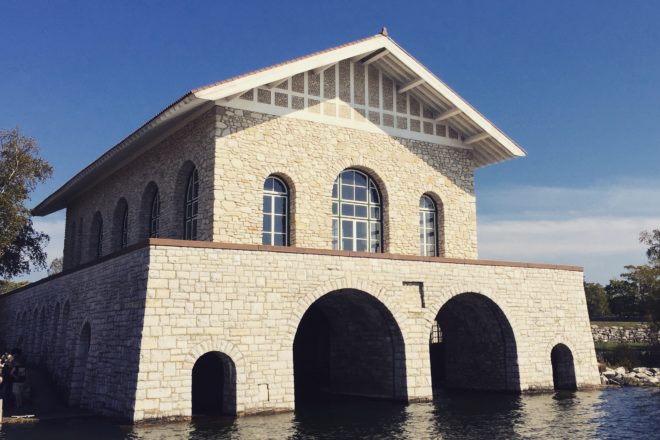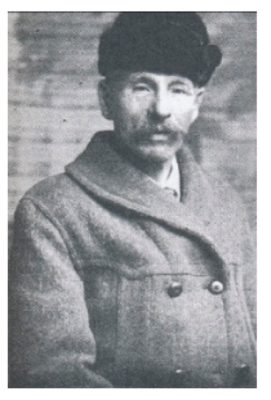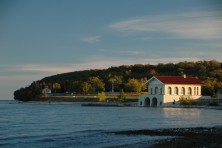Creating Rock Island State Park
- Share
- Tweet
- Pin
- Share

This is a story shared by two unrelated women whose great-grandfathers were involved – in quite different, but crucial ways – in creating Rock Island State Park.

The Tale of John Buechner Jr.
Cheryl Culver is the great-granddaughter of Johann “John” Wilhelm Buechner Jr., born July 30, 1881, in Marathon County, Wisconsin. He was the fourth of Johann and Rosalina (Erdmann) Buechners’ 11 children. Both of his parents, along with a number of relatives – Krugers, Weisners and Erdmanns – had immigrated from Germany, and, although John Jr. spoke English, German was the only language spoken in his home until 1914.
Members of the Buechner family, following many of their cousins, moved to southern Door County in 1901, settling in the Stokes community in the Town of Nasewaupee.
By 1906, John Jr. was employed at the Parkinson Farm, just south of the Frank Murphy Farms (now known as Horseshoe Bay Farms). Back in Nasewaupee for a visit, Buechner accompanied his father to conduct some stonemasonry work at the farm owned by Jacob and Magdalena Staats in the town of Egg Harbor (now Country View Farm, still owned by their descendants). In October 1907, Buechner married Hattie Staats, the “tall, shapely” young woman he’d caught sight of 18 months earlier. He was 26, and Hattie was 21.
That same year, The Advocate reported that John Sr. and John Jr. were building a 40-foot-by-60-foot stone barn. By the time of the 1910 census, John Jr., Hattie and their first child, Helen, were living at 152 W. Maple in Sturgeon Bay, and he was self-employed as a stonemason. Apparently, he was busy because he had just taken on John Spude as a partner.
John Buechner Jr.’s family experienced many heartaches. In 1910 and 1911, two more children were born and died in infancy. In March 1914, John’s two younger sisters, ages 16 and 20, died of diphtheria just a day apart, and, within a week, his father died of heart failure. A few months later, their $70.98 milk check (equivalent to $2,962.76 today) was stolen – another devastating loss for a young family. A further tragedy was the drowning of 13-year-old daughter Mae in 1933.
There must have been setbacks in Buechner’s work as a stonemason because the 1920 census listed him as a dairy-farm worker, but later that year, The Advocate reported that he and Albert Schnick, his “mud man,” had finished work on the Hobbins cottages in Two Rivers and were now working for B.D. Thorp at Eagle Inn. In 1922, he completed the fireplaces, chimneys and exterior stone walls for the new Alpine Resort.
In 1923, Buechner began his longest and most magnificent masonry accomplishment as the lead mason for Chester Thordarson’s boathouse and other structures on Rock Island. It was the first of his projects that were eventually named to the Wisconsin and National Registers of Historic Places. Others were the Ephraim Village Hall and the Baileys Harbor Town Hall and McArdle Library.
Additional major projects for which John Buechner Jr. did stonework included the Mill Supper Club, the Rock Supper Club (now Alexander’s), Glidden Lodge, the Forestville Legion Hall (later known as the Forestvilla), the Door County Historical Museum, Gordon Lodge, the Lady of the Lake Catholic Church and Herman Birnschein’s gas station.
In 1941, at age 60, Buechner went to work for the Smith Shipyard in Sturgeon Bay and died two years later of complications from a ruptured appendix.

The Story of Rasmus Hanson
Dixie Jorns is the great-granddaughter of Rasmus Hanson, a Danish immigrant who lived in the Jackson Harbor area of Washington Island at the turn of the 20th century. He was an industrious man, involved with boat building, shipping and logging, and he purchased the interior of Rock Island, planning to log the timber.
In earlier days, transient Native American tribes had used Rock Island for fishing, and by the time the Pottawatomie Lighthouse was built in 1836, Jesse Minor, one of the first lightkeepers, reported as many as 50 wigwams coexisting with a village of families that occupied the east side of the island. By the mid-1800s, however, the island was all but empty, apart from the lightkeeper’s family.
About 1910, Chester Thordarson, an Icelandic immigrant and self-made millionaire from the Chicago area, became interested in purchasing land around Washington Island.
During that time, Hanson’s family was suffering hardships. After losing two infant daughters, his wife, Rasmine, was very depressed and longed to see her family in Denmark. Rasmus sold his holdings on Rock Island to Thordarson to finance her trip, but Rasmine contracted
pneumonia on the journey back from Denmark and died in a boarding house in Sister Bay.
After purchasing Hanson’s land, Thordarson began to develop the island. Believing that Icelanders were the best craftspeople, he advertised for workers in Canadian newspapers that had circulations in communities with large concentrations of Icelandic immigrants. A young man named Daniel Lindal was one of the nine laborers who went to work on Rock Island.
A massive stone boathouse, big enough for two 50-foot yachts, was built, along with a few other smaller structures. As those buildings began to be built, Agnes Hanson, Rasmus’ daughter, was one of the people who delivered supplies to the island. She caught Lindal’s eye, and they eventually married. Lindal worked for Thordarson until the day he suggested that the workers should be given a coffee break during the day and was fired on the spot.
But that did not end the Lindal family’s connection with Rock Island. Daniel’s sister, Helga, moved there and married Thordarson’s son, Dewey, in 1931. Chester Thordarson died in 1945 and was buried on Rock Island.
In early 1961, officials of the Town of Washington Island, led by town chair Jack Hagen, proposed that Rock Island become a state park. A feasibility study was conducted in September 1961, and the Door County Board approved the acquisition Dec. 11, 1961.
In the spring of 1962, the state Department of Conservation negotiated with Dewey Thordarson, who was administering his late father’s estate, and on July 17, 1962, an agreement was reached, stipulating that the conservation department would exercise temporary custodial care of the property, along with the option to purchase the land for a park in the future.
That agreement expired Aug. 31, 1963, and funds were not available to purchase the island. But, in order to keep the land undeveloped for a longer time while waiting for the state legislature to approve funding, a three-year scenic easement was purchased for $5,000, which counted toward the eventual purchase price. The property was finally purchased in April 1965.
Dewey Thordarson died in 1968 at age 70, and Helga in 2001 at age 95. Both are buried in the Washington Island Cemetery.
Ten buildings on Rock Island, including the boathouse, are part of the Thordarson Estate Historical District, which was placed on the National Register of Historic Places in 1985 and on the Wisconsin Register of Historic Places in 1989.
Cheryl Culver’s great-grandfather, John Buechner Jr. – known as “Egg Harbor’s man of stone” – was the chief stonemason on the boathouse and many of the other buildings on Thordarson’s estate. And it’s quite possible that there would never have been a state park on Rock Island had Dixie Jorns’ great-grandfather, Rasmus Hanson, not sold his land there to pay for his homesick wife’s ill-fated visit to her family in Denmark.


